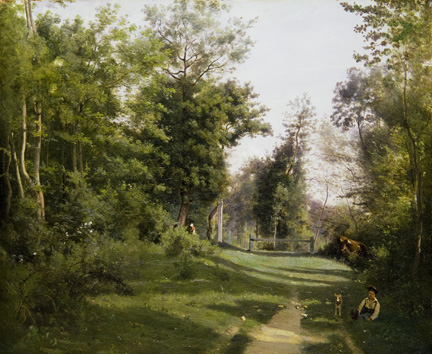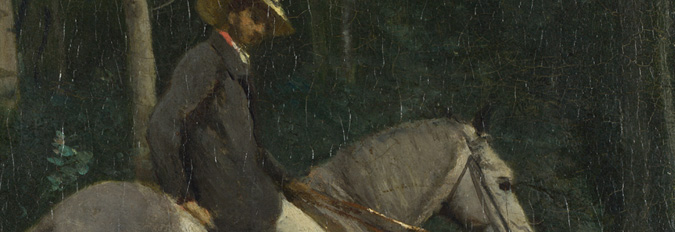Subject
A man on a dappled grey horse, set against the darkness of the wood, turns to look at the viewer. He wears grey trousers, a dark red jacket, a red necktie (just glimpsed) and a yellowish straw hat with a black band, which forms the brightest tone in the picture. Other light touches are provided by the two silver birch trunks to the left and the lighter tones of the foliage.
The rider is Monsieur Joseph Pivot (died 18564 ), whose country residence was at the Côte d’Argent in the village of Ville-d’Avray. He was a neighbour of Corot, whose parents bought a property in the village in 1817 at 3 rue du Lac. Corot’s father and mother died in 1847 and 1851 respectively and thereafter the house was inhabited by Corot’s sister, Annette Octavie. Corot frequently returned to the area to paint, and occupied an attic room on the second floor until the end of his life.
Alfred Robaut relates an anecdote about the painting which is worth quoting in full:
‘The Master showed me a little canvas which was entrusted to him yesterday and which he had seen before in singular circumstances. Around twenty years ago a certain M P(ivot), owner of a neighbouring estate to that of the Master, was passing by on horseback in the Ville d’Avray woods in front of our artist, who, in the middle of doing a study, asked him to stop for a moment so that he could do a quick sketch of him. The honest merchant let him do this. Some time later he died, and the dear Master thought that it would be an act of kindness to send this canvas to his widow.
‘He had never received either congratulations or thanks for this; what is more, the most basic acknowledgement that it had been received had not even reached the generous donor, and he got to the point of wondering whether the errand had been carried out properly. To be brief, passing by there yesterday (22 October 1873) in the company of the doctor C(ambray), to whom the story had just been told, they had the idea of going in and taking a chance and asking to see the work. The lady of the house arrived, and the Master made the excuse that the little canvas which he had once sent her pleased him very much and he told her that he wanted to copy it.
‘At once as the lady made as if to fetch it, M. Corot told her that he wanted her to take it out of the frame, which would get in his way, and she replied artlessly: ‘Oh, but that is very easy, we have never put it in a frame’. This painting, lent to Corot by Mme Pivot at his request, remained in the artist’s studio until his death. Included by mistake in the paintings to sell, it was put into the posthumous sale (under lot 358) from which it was withdrawn and returned to Mme Pivot.’5
This anecdote ties in with the visual evidence as described under Technical notes. It is probable that Corot had with him a wider canvas at the time when Monsieur Pivot appeared (but not one which he was actively using), and that he painted the sketch of Pivot and some of the greenery over this initial landscape. Later, back in the studio, he apparently cut the canvas down on the right and re-stretched it before finishing off the painting.
At this point he further reworked the setting in which the horse and rider stand, and probably added the slender curved trunks of the silver birches. It is not in any way an accurate representation of the actual landscape Corot was working in, and in fact differs greatly from the landscape visible in the X-radiograph. This landscape, with its path and pillar or post, can be compared with 'Ville-d’Avray: A Path in the Woods' of 1850–5 (R681; fig. 5).

The path, pillar and disposition of the trees in this painting all suggest that this is the site of the original landscape of Monsieur Pivot. Corot carried out much more reworking in the lower half of the picture, such as the addition of the foliage in light blue-greens, but he left the top half quite sketchy, and the green paint is applied fairly thinly, especially top left where the pale blue paint is visible.

